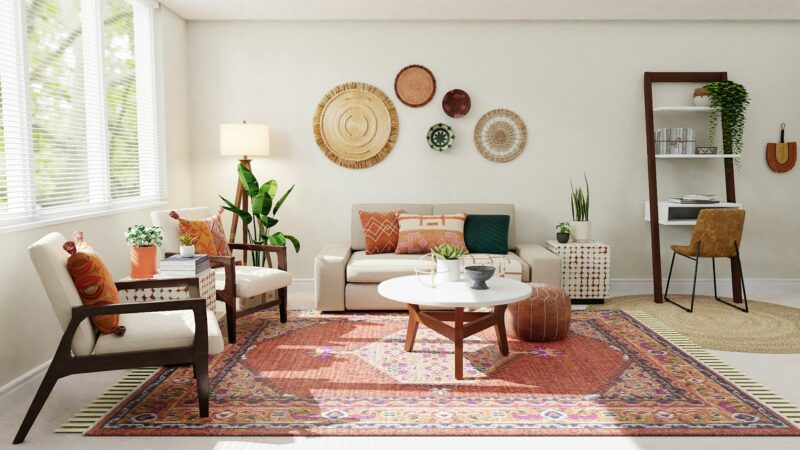Within the field of interior design, there is an alluring aesthetic that defies traditional conventions and embraces uniqueness, innovation, and diversity. In the world of interior design, eclectic home decor—which is defined by the blending of several styles, eras, textures, and colors—has become a shining example of artistic freedom and self-expression.
The ability to combine many components, including Target home decor, into a harmonious and eye-catching tapestry to create places that are both distinctive and naturally welcoming is what distinguishes eclectic décor. In this thorough investigation, we explore the core of eclectic home design, revealing the mysteries that underlie its attractiveness and looking at the reasons that it is so widely accepted.
The Essence of Eclecticism

Fundamentally, eclectic home design disavows the idea of rigid devotion to a single style or theme and instead embraces variety. Rather, it incorporates a diverse range of inspirations, from modern and avant-garde to vintage and traditional. People are able to design environments that showcase their diverse interests and complex personalities because of this openness to diversity.
Contrary to more conventional designs like Scandinavian or minimalist, which emphasize restraint and simplicity, eclectic decor is all about the contrast between disparate pieces. A sleek, modern sofa and an antique Persian rug may coexist peacefully in a room with a variety of funny trinkets that give the place personality and charm. The unique charm of eclectic interiors stems from this element of surprise and unpredictability, which begs investigation and discovery at every step.
The Art of Mixing and Matching
The concentration on imagination and originality that characterizes eclectic home design is one of its distinguishing qualities. In contrast to strictly following design guidelines, eclectic style enables people to follow their intuition and try out unusual pairings. The ability to combine various textures, colors, and styles creates countless possibilities and encourages creativity in the creative process.
A Moroccan-inspired coffee table and a mid-century contemporary recliner make a statement in an eclectic living area. Vibrant throw cushions give visual interest and flashes of color.
DIY home decor ideas can help tie these elements together, adding a personal touch to the space. Finding a balance between the many components is crucial to making sure that every ingredient enhances the composition as a whole without overpowering the senses.
Unique pieces like the Oreo Stool HomeGoods can further elevate the design, blending functionality with creativity. People may unleash their inner artists and create settings that are as distinctive and eclectic as they are by embracing eclecticism.
Personal Expression: Making It Your Own
The ability of eclectic home décor to express oneself is maybe its most alluring feature. In contrast to homogenous interiors devoid of personality and soul, eclectic environments mirror the people who live there. Whether it’s a treasured antique handed down through the ancestors or something you found at a flea market on a weekend excursion, every item has a story to tell.
In an eclectic bedroom, a vintage vanity table functions as a delightful display for a variety of perfumes and trinkets, while a gallery wall decorated with an eclectic mix of artwork acts as a visual journal of memories and experiences. People can create surroundings that are warm and genuine by adding personal touches and important artefacts to their spaces.
Creating Visual Harmony: The Importance of Balance
Even though eclectic home decor values uniqueness and diversity, it’s crucial to achieve visual harmony to keep the area from appearing disorganized or disorganized. Achieving a unified and harmonious composition by carefully balancing competing elements is crucial for the successful implementation of eclecticism.
Using a unifying color scheme or theme to bring the diverse parts together is an efficient way to achieve balance. Creating a sense of consistency across the space helps to create a cohesive visual narrative, whether it’s through the use of a harmonious mix of textures and materials or a neutral basis accented by vivid accent colors.
In addition, achieving a feeling of balance in eclectic interiors requires careful consideration of scale, proportion, and location. Individuals can make sure that every component contributes to the space’s harmonious flow by carefully evaluating the relationships between different pieces and how those relationships affect the composition as a whole.
Inviting Ambiance: Cultivating Comfort and Warmth

Eclectic home décor is really about making rooms feel comfortable and inviting, not simply about looks. Eclectic designs are meant to convey a feeling of coziness and warmth, whether it’s a bright dining room that invites guests to stay or a small reading nook nestled away in a corner.
Making thoughtful use of textiles and soft furnishings is one method to create a welcoming atmosphere. In addition to adding layers of texture and complexity, plush carpets, tactile throws, and large cushions also encourage tactile exploration, which promotes leisure and relaxation.
Apart from textiles, lighting is a crucial factor in determining the overall atmosphere of eclectic environments. Lighting fixtures can act as focal points and also set the mood and environment. Examples of this are statement chandeliers, pendant lights, vintage-inspired lamps, and candle sconces.
Moreover, bringing in natural elements from the outside, including organic materials, indoor plants, and botanical prints, helps create a sense of calm and vibrancy in the room. People can create situations that seem uplifting and renewing, encouraging a sense of well-being and tranquility, by utilizing the power of nature. Check out At Home Tulsa for inspiration on incorporating these elements into your space
Final Words
A ray of uniqueness and self-expression, eclectic home décor shines out in a world where conformity and homogeneity are the norm. Interiors may be made to be as distinctive and hospitable as the people creating them if they embrace diversity, let their creativity run wild, and add personal touches to rooms. Eclectic decor offers countless opportunities for self-discovery and exploration, whether it’s through the skillful blending of styles, textures, and colors or the deliberate curation of meaningful things and recollections. building places that represent who we are and how we want to live, encouraging us to embrace our true selves and appreciate the rich tapestry of life, is ultimately more important than simply building beautiful spaces.

